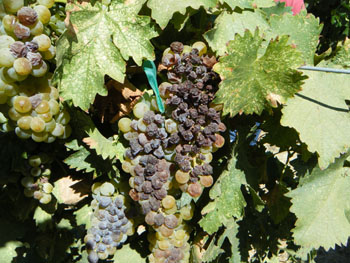Eric Stafne, Mississippi State University
Sunscald manifests as a discoloration on grape clusters, which may appear as browning, cracking, or shriveling. Although sunscald is an abiotic disorder (not caused by pests), development of fruit rots also have been associated with sunscald damage.
Sunscald can be a significant problem in regions with intense sunlight, or following extreme heat spikes in cooler regions – particularly after veraison when berries begin to soften. Direct sunlight on unprotected clusters, typically on clusters that began their development in shade, is common. Drought conditions may exacerbate the effects, as well as management practices like leaf removal, summer pruning, and shoot positioning. Row orientation to reduce fruit exposure to the hottest sunlight should be taken into account to decrease the potential for sunscald.
Recommended Resources
Sunscald Damage, Michigan State University
Sunscald Prevention, University of Idaho
Grapevine Problems: Leaf Spots Not Caused by Insects or Disease
Hail Damage to Vines and Fruit
Reviewed by Tim Martinson, Cornell University and Fritz Westover, Texas AgriLife Extension

